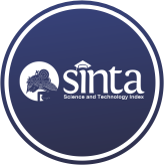enerapan Metode Weighted Product Untuk Penerima Insentif Karyawan
(1) Universitas Putra Indonesia “YPTK”, Padang, Indonesia
(2) Universitas Putra Indonesia “YPTK”, Padang, Indonesia
(3) Universitas Putra Indonesia “YPTK”, Padang, Indonesia
(*) Corresponding Author
Abstract
The development of science from time to time has succeeded in bringing humans into an era of information technology. Organizations need to change the way they manage and develop human resources in the face of technological change. Stakeholders need to evaluate employee performance periodically so that it can become a reference for determining employee incentives. Partial incentives will have a positive effect on psychological empowerment which will then also have a positive effect on employee performance. This research aims to build a Decision Support System in determining employee incentive recipients. The method used in this research is the weighted product method. This method has six stages, namely the alternative value of each criterion, the alternative value of each criterion after weighting, determining the preference weight of the criteria, calculating the preference value of Vector S, calculating the value of Vector V, and ranking results. The processed dataset comes from Institut Teknologi dan Bisnis Haji Agus Salim Bukittinggi. The dataset consists of 14 employee data with their respective criteria values. The results of this research can determine employee incentive recipients with an accuracy rate of 86%. Therefore, this research can be a reference for stakeholders to determine recipients of employee incentives in a certain period.
Full Text:
PDFReferences
J. Wang, W. Bai, and Y. Liu, “Optimization for the Human Resources Management Strategy of the IoT Industry Based on AHP,” Comput. Intell. Neurosci., vol. 2022, no. 2, pp. 1–10, 2022, doi: 10.1155/2022/3514285.
F. Akilah and D. Rahman, “Telaah Fungsional Konsepsi Insentif Terhadap Kepuasan Kerja Pegawai,” vol. 10, no. 2, pp. 187–196, 2020.
Sutrisno, M. M. Amalia, K. Mere, A. Bakar, and N. D. C. Arta, “Dampak Pemberian Motivasi Dan Insentif Terhadap Kinerja Pegawai Pada Perusahaan Rintisan: Literature Review,” vol. 4, no. 2, pp. 1871–1881, 2023.
D. Xu, T. Tu, and X. Xiao, “Talking about the Innovative Application of Big Data in Enterprise Human Resources Performance Management,” Math. Probl. Eng., vol. 2022, pp. 1–12, 2022, doi: 10.1155/2022/4047508.
I. Purnamasari and M. Fajria, “Identifikasi Karyawan Terbaik dengan Sistem Pendukung Keputusan Metode Weighted Product,” vol. 11, no. 1, pp. 1–8, 2022.
M. Akib, N. Mirosea, and L. Angga, “Dampak Umpan Balik dan Insentif Terhadap Kinerja Auditor Internal Pemerintah,” vol. 6, no. 1, pp. 42–52, 2021.
D. A. Nani and C. A. Vinahapsari, “Efektivitas Penerapan Sistem Insentif Bagi Manajer Dan Karyawan,” J. Bisnis Darmajaya, vol. 6, no. 1, pp. 44–54, 2020.
L. Wang, “Intelligent Decision Support System of Emergency Language Based on Fog Computing,” vol. 1, pp. 1–11, 2023.
L. Cao, “Design and Optimization of a Decision Support System for Sports Training Based on Data Mining Technology,” Sci. Program., vol. 2022, pp. 1–12, 2022, doi: 10.1155/2022/1846345.
Q. Li, Y. Dong, R. G. Cao, L. Li, and Z. Bin Chen, “A Decision Support System for Optimal Building Cold Source Selection,” Shock Vib., vol. 2022, pp. 1–13, 2022, doi: 10.1155/2022/5605477.
V. M. M. Siregar, S. Sonang, and E. Damanik, “Sistem Pendukung Keputusan Penentuan Pelanggan Terbaik Menggunakan Metode Weighted Product,” J. Tek. Inf. dan Komput., vol. 4, no. 2, p. 239, 2021, doi: 10.37600/tekinkom.v4i2.392.
Supiyandi, R. Nasrul Fuad, E. Hariyanto, and S. Larasati, “Sistem Pendukung Keputusan Pemberian Kredit Koperasi Menggunakan Metode Weighted Product,” J. Media Inform. Budidarma, vol. 4, no. 4, pp. 1132–1139, 2020, doi: 10.30865/mib.v4i4.2367.
F. A. R. Seran, Y. P. K. Kelen, and D. Nababan, “Sistem Pendukung Keputusan Penentuan Jurusan Menggunakan Metode Weighted Product,” J. Tekno Kompak, vol. 17, no. 1, pp. 147–159, 2020.
DOI: https://doi.org/10.30645/kesatria.v5i2.358
DOI (PDF): https://doi.org/10.30645/kesatria.v5i2.358.g355
Refbacks
- There are currently no refbacks.
Published Papers Indexed/Abstracted By:














